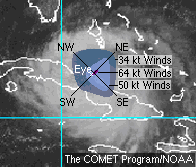|
The wind radii information contained in the tropical cyclone forecast/advisory takes a bit of decoding. We'll
take the first forecast in the example forecast/advisory and work through it.
FORECAST VALID 24/1800Z 21.9N 78.1W
MAX WIND 65 KT...GUSTS 80 KT
64 KT... 30NE 0SE 0SW 0NW
50 KT...100NE 100SE 30SW 30NW
34 KT...135NE 125SE 75SW 125NW
The first line
FORECAST VALID 24/1800Z 21.9N 78.1W
says that the forecast is valid on the 24th day of the month at 1800Z
(2 p.m. EDT) and then gives the forecasted latitude and longitude of the storm's center (21.9N
78.1W).
The second line
MAX WIND 65 KT...GUSTS 80 KT
gives the predicted maximum sustained wind speed (65 kt or 75 mph) and the
peak gust expected (80 kt or 92 mph).
The third line
64 KT... 30NE 0SE 0SW 0NW
tells how far from the center of the storm the 64 kt (74 mph, or hurricane-force) winds extend in the northeast,
southeast, southwest, and northwest directions. The distance is given in nautical miles (abbreviated NM; 1 NM equals
1.15 statute miles). So in the northeast direction, the hurricane-force winds extend out 30 NM, but there are no
hurricane-force winds in any of the other directions.
The fourth and fifth lines
50 KT...100NE 100SE 30SW 30NW
34 KT...135NE 125SE 75SW 125NW
give the same information for the 50 kt (58 mph) and 34 kt (39 mph, or tropical storm-force) winds. The
location of the tropical storm-force winds are critical because, as will be seen in the Decision Making section,
they help define when certain preparedness actions must be taken or completed.
|
 A diagram of the
wind radii from the above example is illustrated by the figure to the right. The significance of this information
depends on what direction the storm is moving, where you are in relation to it, and how symmetrical the storm is.
In this example, you can see that the wind fields are not very symmetrical (because the storm had travelled over
Cuba's land surface for some time). If the hurricane were heading north, locations northeast of the center would
experience stronger winds than those to the northwest (unless the storm changed direction or the wind field enlarged).
If the storm were moving west, tropical storm-force winds would reach areas on the northwest side of the storm
sooner than locations on the southwest side.
A diagram of the
wind radii from the above example is illustrated by the figure to the right. The significance of this information
depends on what direction the storm is moving, where you are in relation to it, and how symmetrical the storm is.
In this example, you can see that the wind fields are not very symmetrical (because the storm had travelled over
Cuba's land surface for some time). If the hurricane were heading north, locations northeast of the center would
experience stronger winds than those to the northwest (unless the storm changed direction or the wind field enlarged).
If the storm were moving west, tropical storm-force winds would reach areas on the northwest side of the storm
sooner than locations on the southwest side.